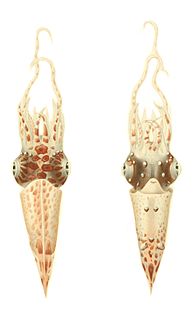
The Enoploteuthidea are a family of squid comprising approximately 40 species in four genera. Most species have a mantle length ranging from 3–13 cm. Hooks are present on all arms and tentacles. The family is best known for the large array of photophores throughout the body.
Euprymna hoylei is a species of bobtail squid native to the tropical waters of the Indo-Pacific, specifically the western Pacific Ocean and northwestern Australia. Little is known about the size range of this species.

Sepiolinae is a subfamily of bobtail squid encompassing 5 genera and more than 30 species.

Pteroctopus is a genus of octopuses in the family Octopodidae.

Abraliopsis is a genus of squid in the family Enoploteuthidae comprising 11 nominal species. Species are characterised by the presence of photophores on arm pair IV. Suckers are absent from this arm. The type species is Abraliopsis hoylei.

Pterygioteuthis giardi is a species of squid in the family Pyroteuthidae. It is known as the roundear enope squid. The specific name honors the French zoologist and marine biologist Alfred Mathieu Giard (1846-1908).

Abraliopsis morisii is a species of bioluminescent squid in the family Enoploteuthidae. The species occurs in tropical to warm temperate waters in the Atlantic Ocean, including the Gulf of Mexico and the Mediterranean Sea. It can be found in the epipelagic and mesopelagic zones. Jean Baptiste Vérany described the species in 1839 and it reaches lengths of 25 to 33 millimetres. It is rated as least concern by the International Union for Conservation of Nature (IUCN).
Abralia omiae is a species of enoploteuthid cephalopod known only from its type locality, the Dimitry Mendeleyev seamount in the Pacific tropics. A. omiae is a small species, less than 3 cm in mantle length.

Abralia siedleckyi is a species of enoploteuthid cephalopod known from its type locality in the waters off South Africa. It resembles A. heminuchalis, and may be synonymous with it.
Abraliopsis affinis is a species of enoploteuthid cephalopod in the tropical waters of the eastern Pacific Ocean, and is known from Chile, Colombia, Costa Rica, Ecuador, El Salvador, Guatemala, Honduras, Mexico, Nicaragua, Panama and Peru. It was described by Pfeffer in 1912 and is rated as a least-concern species by the IUCN.
Abraliopsis atlantica is a species of enoploteuthid cephalopod found in the tropical and subtropical Atlantic Ocean, including the Caribbean Sea, the Gulf of Mexico and the Benguela Current. Female oocytes are around 1 mm in length and number between 4,000 and 29,000 in mature females. There is a lack of information about the species and it is rated as data deficient by the International Union for the Conservation of Nature (IUCN) due to this. It was described by Kir Nesis in 1982.
Abraliopsis chuni is a species of enoploteuthid cephalopod known from Indo-Pacific waters. Very little is known of this species.
Abraliopsis falco is a species of enoploteuthid cephalopod found in the tropical waters of the East Pacific Ocean, and is known from Chile, Colombia, Costa Rica, Ecuador, El Salvador, Guatemala, México, Nicaragua, Panamá, Perú and the United States. Females are larger than males, reaching sizes of 41–46 mm mantle length, with males reaching 35–37 mm mantle length.

Abraliopsis felis is a species of enoploteuthid cephalopod found in cool temperate water of the north Pacific Ocean. Female oocytes measure 1.5 mm in length.
Abraliopsis gilchristi is a species of enoploteuthid cephalopods found in southern temperate waters of the south Pacific Ocean, from New Zealand to South Africa, where it is abundant. It undergoes a vertical daily migration spending the day at depth and moving closer to the surface at night to feed on copepods, euphausiids and hyperiids. Spawning appears to occur between September and December. The specific name honours the Scottish zoologist John Gilchrist (1866-1926) who was the first director of the Marine Biological Survey in Cape Town. The type specimen was taken off Cape Town and is held in the Natural History Museum, London.
Abraliopsis lineata is a species of enoploteuthid cephalopod native to Indo-Pacific waters, from the Arabian Sea and the Mascarene Islands in the west to Japan, Indonesia and French Polynesia in the east. It occurs in relatively shallow water at depths of ~100 m during the day.
Abraliopsis pacificus is a species of enoploteuthid cephalopod from the northwestern Pacific Ocean, from Japan to Hawaii. This species undergoes vertical migration from 900–500 m depth during the day, rising to 263–102 m depth at night. Male spermatophores are 6.5–7 mm in length.
Abraliopsis tui is a species of enoploteuthid cephalopod found in the waters around New Zealand and the Kermadec Islands.

Stigmatoteuthis is a genus of squid from the family Histioteuthidae. They occur in the Oceans from the tropics south to the temperate seas.
Pterygioteuthis hoylei is a species of squid in the family Pyroteuthidae. It is considered conspecific with Pterygioteuthis giardi by some authorities. It can be identified from P. giardi by having four photophores on the tentacles and many chromatophores spread along the tentacle stalk and around the aboral surface of the tentacular club. It is also slightly larger than P. giardi, it has been so far recorded only from the eastern tropical Pacific Ocean where it is the only species of in the family Pyroteuthidae to occur there, although its actual distribution may be wider than currently known. The specific name honours the British malacologist William Evans Hoyle (1855-1926).










